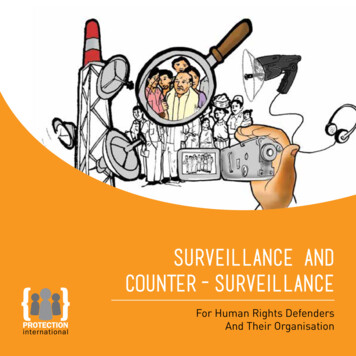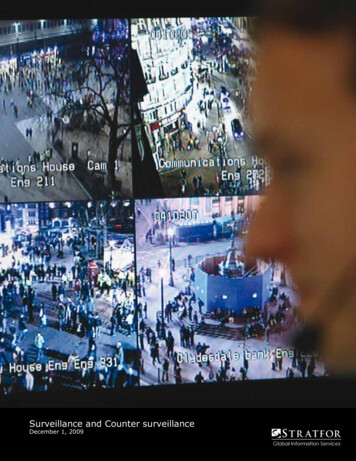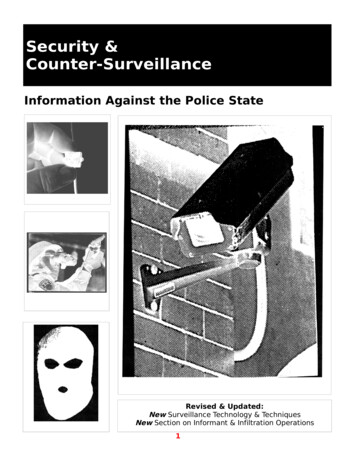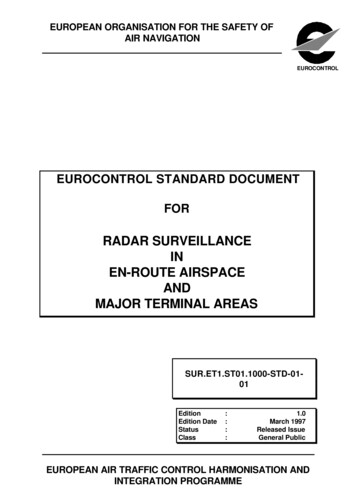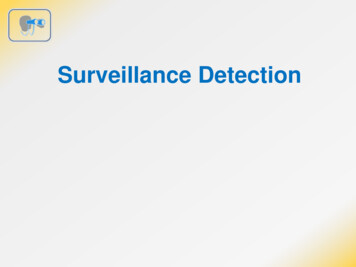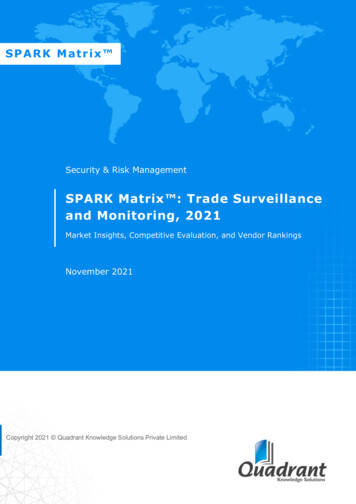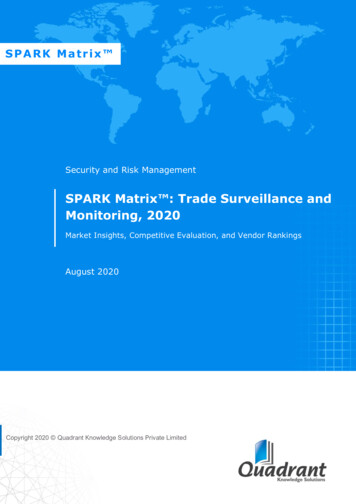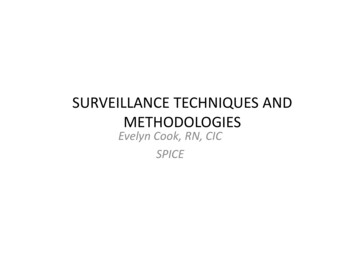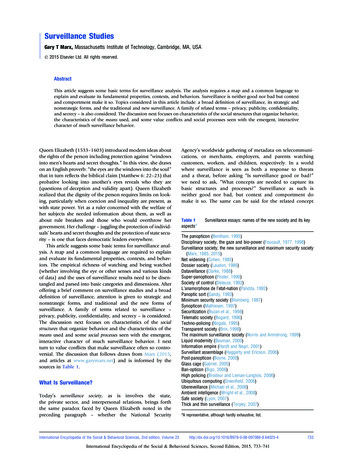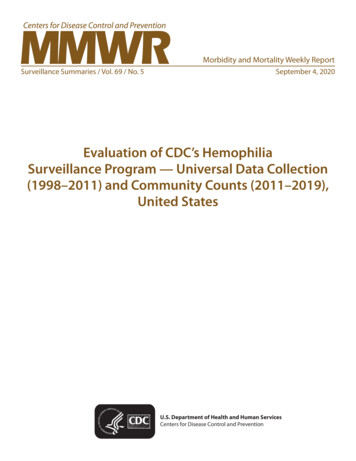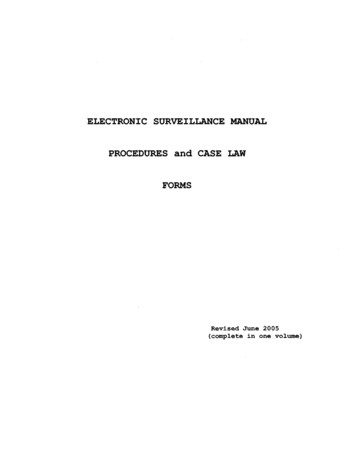
Transcription
ELECTRONIC SURVEILLANCE MANUALPROCEDURES and CASE LAWFORMSR e v i s e d J u n e 2005(complete i n one voliime)
FOREWORDThis manual was prepared by the Electronic SurveillanceUnit, Office of Enforcement Operations, Criminal Division, and isdesigned primarily to assist federal prosecutors andinvestigative agents in the preparation of electronicsurveillance applications made pursuant to Title 18, UnitedStates Code, Sections 2510-2522 (2001) ("Title III") andassociated statutes. It is not intended to confer any rights,privileges, or benefits upon defendants, nor does it have theforce of a United States Department of Justice directive. SeeUnited States v. Caceres, 440 U.S. 741 (1979). In addition tooutlining and discussing the statutory requirements of Title IIIapplications, this manual also sets forth the Department'sauthorization process, provides guidance in filing Title IIIpleadings before the court, and discusses the applicable case lawas well as both novel, and frequently arising, legal issuesinvolved in Title III litigation. Samples of the most commonlyfiled pleadings follow the text.
INTRODUCTIONThis manual sets forth the procedures established by theCriminal Division of the Department of Justice to obtainauthorization to conduct electronic surveillance pursuant toTitle 18, United States Code, Sections 2510-2522 (2001) (Title IIIof the Omnibus Crime Control and Safe Streets Act of 1968, asamended by the Electronic Communications Privacy Act of 198 6(ECPA), the Communications Assistance for Law Enforcement Act of1994 (CALEA), the Antiterrorism and Effective Death Penalty Actof 1996 (Antiterrorism Act)), the USA-Patriot Act of 2001, andthe Homeland Security Act of 2002 and discusses the statutoryrequirements of each of the pleadings. Throughout this manual,the above federal wiretap statutes will occasionally be referredto collectively as "Title III."This manual is divided into two sections. The first sectionprovides an overview of the procedures to follow when applyingfor authorization to conduct electronic surveillance, anddiscusses format, statutory and policy requirements, andpertinent case law concerning specific electronic surveillanceissues. The second section provides sample forms pertaining toelectronic surveillance involving wire, oral and electroniccommunication interceptions, pen register/trap and traceprocedures, access to transactional data and stored wire andelectronic communications, and the use of tracking devices.These forms are intended only to provide general guidance indrafting the most frequently used pleadings and do not prohibitalternative approaches.11
TABLE OF CONTENTSI.THE ELECTRONIC SURVEILLANCE UNIT1II.TITLE III AUTHORIZATION PROCESS1III. THE ELECTRONIC SURVEILLANCE PLEADINGS1.2.3.IV.33715The ApplicationThe AffidavitThe OrderELECTRONIC COMMUNICATIONS1.Coverage under Title III2.Stored Electronic Communications - 18 U.S.C. § 2703161616V.EXTENSION AND SPINOFF APPLICATIONS1.Extension Applications2.Spinoff Applications191921VI.ROVING INTERCEPTIONS1. Roving Oral Interception2. Roving Wire or Electronic Interception222324VII.EMERGENCY PROCEDURES1.Title III Interceptions2.Pen Register/Trap and Trace Devices3.How to Contact the ESUVIII.IX.1.2.3.4.5.6.24242627PROGRESS REPORTS27SEALINGOverviewWhen to SealSealing DelaysHow to Seal/Custody of the TapesSuppression for Failure to Seal ProperlyResealing27272829303031X.INVENTORY NOTICE31XI.DISCLOSURE OF TITLE III EVIDENCE321.18 U.S.C. § 2517(1), (2), (6), (7), (8) - Use andDisclosure of Interception Informationiii32
XII.2.18 U.S.C. § 2517(3) - Testimonial Use3.4.3418 U.S.C. § 2517(4) - Privileged Communications . . 3518 U.S.C. § 2517(5) - Use of "Other Crimes" Evidence35DISCOVERY1.18 U.S.C. § 2518(9), 2518(10) (a)2.The Federal RulesXIII.XIV.XV.363637PEN REGISTERS/TRAPS AND TRACES38CELL SITE SIMULATORS/DIGITAL ANALYZERS/TRIGGERFISH. .40THE LEGAL AUTHORITIES REQUIRED TO LOCATE CELLULAR TELEPHONES41XVI. MOBILE TRACKING DEVICES48XVII.48VIDEO SURVEILLANCEXVIII. CONSENSUAL MONITORING1.Consensual Monitoring by Law Enforcement2.Consensual Monitoring by Private PartiesXIX. CUSTODIAL MONITORING1.Law Enforcement Access to Monitored Prison Calls2.Case Law on Custodial Monitoring505051525254SamplesApplication for Wire and/or Oral Interceptions56Affidavit for Oral and/or Wire Interception63Order for Interception of Wire and/or Oral Communications. .Order to Service ProviderSample Minimization7277Instructionsfor Oral and Wire CommunicationsApplication for Electronic Communications InterceptionAffidavit for Electronic Communications InterceptionOrder for Interception of Electronic CommunicationsIV79. . .85. . . .9099
Sample Title III Roving Affidavit103Application for Approval of Emergency Interception of Wire, Oralor Electronic Communications Under 18 U.S.C. 2518(7) . . 137Affidavit in Support of Application for Approval of EmergencyInterception of Wire, Oral or Electronic CommunicationsUnder 18 U.S.C. 2518(7)143Order Approving Emergency Interception of Wire, Oral orElectronic Communications Under 18 U.S.C. 2518(7). . . 153Application for Sealing157Order for Sealing160Application for 2703(d) Court Order1622703(d) Court Order164Application for Trap and Trace/Pen Register166Order for Trap and Trace/Pen Register168Application for Order Permitting Government To Use Its Own PenRegister/Trap and Trace Equipment (Triggerfish/DigitalAnalyzer or Similar Device171Order Permitting Government To Use Its Own Pen Register/Trap andTrace Equipment (Triggerfish/Digital Analyzer or SimilarDevice)173Combined 3123/2703 Application175Combined 3123/2703 Order189Application for Video Surveillance197Order for Video Surveillance201Application for Disclosure204Order for Disclosure of Interceptions207Section 2517(5) Application for Testimonial Useof Interceptions Relating to "Other Offenses"209V
Section 2517(5) Order Permitting Testimonial Useof Interceptions Relating to "Other Offenses"212Inventory Application214Order for Inventory216Inventory Notice218Application for Destruction of Tapes219Order for Destruction of Tapes222Affidavit for Mobile Tracking Device224Order for Mobile Tracking Device227VI
I.THE ELECTRONIC SURVEILLANCE UNITThe Electronic Surveillance Unit (ESU) operates within theOffice of Enforcement Operations (OEO), Criminal Division, andhandles all requests made pursuant to Title III to conductnon-consensual, domestic surveillance of wire, oral, andelectronic communications for law enforcement purposes. The ESUdoes not handle state wiretaps or requests to conduct domesticnational security electronic surveillance pursuant to the ForeignIntelligence Surveillance Act of 1978 (50 U.S.C. §§ 1801, etseq.)(FISA). Questions concerning FISA taps should be directedto the Office of Intelligence and Policy Review at (202)514-5600.Attorneys in the ESU are responsible for reviewing andprocessing all Title III requests, and are available to assist inthe preparation of Title III applications and to answer questionson any Title Ill-related issue. All such inquiries should bedirected to (202) 514-6809. ESU attorneys will also provideassistance in responding to suppression motions and preparingbriefs on Title III issues. For assistance in this area, contactthe Chief or Deputy Chief of the ESU at the above number.II.TITLE III AUTHORIZATION PROCESSThe following is a brief explanation of the Department ofJustice's procedures for reviewing and authorizing Title IIIapplications.1. A copy of the proposed order, application, and affidavitis submitted to the ESU and to the Washington, D.C., office ofthe investigative agency handling the case. Those pleadingsshould be sent to the Office of Enforcement Operations,Electronic Surveillance Unit, 1301 New York Avenue, N.W., 12" Floor, Washington, D.C. 20005, and should be sent via overnightmail. If the documents are short enough, they may be faxeddirectly to the ESU at (202) 616-8256. For security reasons,these pleadings may not be sent via e-mail.Except in the case of genuine emergencies, discussed below,most original applications require approximately one week toreview and process from the time the ESU receives the affidavit.Spinoff requests (i.e., applications to conduct electronicsurveillance at a new location or over a new facility that arerelated to an ongoing or previously conducted interceptionreviewed by the ESU) are considered original applications and arereviewed and processed in the same manner described below, andrequire agency approval. Extension requests (i.e., applications1
to continue interceptions over the same facility or premises)require review only by the ESU, and not the investigative agency.Because the ESU is presently reviewing approximately 1,700 TitleIII applications per year, it is imperative when coordinating aninvestigation or planning extension requests that sufficient timeis allowed for the Title III application to be reviewed by boththe ESU and, when appropriate, the investigative agency.2. When an application is received in the ESU, it is loggedin and assigned to one of the reviewing attorneys. This attorneywill be responsible for reviewing all spinoffs and extensionsarising from the original application. The attorney will discusswith the Assistant United States Attorney (AUSA) handling thecase any necessary changes or additions to the affidavit, andwill coordinate the processing of the request with theinvestigative agency's Office of Legal Counsel or, in the case ofthe FBI, the appropriate section wit*hin the CriminalInvestigative Division. Once the affidavit has been reviewed byboth the ESU attorney and the investigative agency's counsel andis in final form, the head of the investigative agency will send,through the ESU, a memorandum to the Assistant Attorney General(or Acting Assistant Attorney General) for the Criminal Divisionrequesting that electronic surveillance be authorized in thiscase. Because it is the investigative agency that has theultimate responsibility for conducting the requested electronicsurveillance, the ESU cannot recommend approval of a Title IIIuntil this agency memorandum has been finalized.(The agencymemorandum is required only for original applications and spinoffapplications involving a new facility or location; it is notrequired for an extension request.) Minor changes or additionsto the affidavit can usually be faxed to the ESU and theinvestigative agency for insertion in the original; however, inthose cases when an affidavit needs substantial revision, a newcopy must be submitted. Generally, an AUSA's only contact personwill be the ESU attorney assigned to the case. Any problems orchanges requested by the investigative agency's counsel will becommunicated to the affiant by the agency after consultation withthe ESU attorney.3. After reviewing the application, the ESU attorney willwrite an action memorandum to the Assistant Attorney General(AAG), Criminal Division, summarizing and analyzing the relevantfacts and legal issues as they pertain to the proposed electronicsurveillance, and discussing the application's compliance withthe statutory requirements of Title III. This memorandum alsocontains the ESU's recommendation of approval or disapproval ofthe application. Once the reviewing attorney has written theaction memorandum, a package is prepared containing the
memorandum and the pleadings. This package, together with therequesting memorandum from the head of the investigative agency,is then sent to the AAG's office for final review andauthorization.4. If the application is authorized, the ESU will fax theAUSA the following items: the authorization document, which is amemorandum from a properly designated official to the Director ofOEO, authorizing the application for Title III surveillance, anda copy of the Attorney General's most recent delegation order,which identifies those individuals to whom the Attorney Generalhas delegated authority to authorize Title III applications. Thedesignated official's authorization memorandum and the copy ofthe Attorney General's delegation order should be filed with thepleadings.III. THE ELECTRONIC SURVEILLANCE PLEADINGSDiscussed below are the requirements for each of the threedocuments comprising a Title III application: the Application,the Affidavit, and the Order. These requirements, which are setforth in 18 U.S.C. § 2518, are applicable to requests for oral,wire and electronic communications. Samples of each of thesepleadings are found in the Forms section.1.The Applicationa. It must identify the applicant (an AUSA) as a lawenforcement or investigative officer, and must be in writing,signed by the AUSA and made under oath. 18 U.S.C. § 2518(1) . Itmust be presented to a federal district court or court of appealsjudge, and be accompanied by the Department's authorizationmemorandum signed by an appropriate Department of Justiceofficial. See 18 U.S.C. §§ 2516(1) and 2510(9)(a); In re UnitedStates, 10 F.3d 931 (2d Cir. 1993) (explaining that "judge ofcompetent jurisdiction" does not include magistrate judges),cert, denied sub nom. Korman v. United States, 513 U.S. 812(1994).b. It must identify the type of communications to beintercepted. 18 U.S.C. § 2518(1)(b)(iii). "Wire communications"are "aural transfers" (involving the human voice) that aretransmitted, at least in part by wire, between the point oforigin and the point of reception, i.e., telephone calls. 18U.S.C. § 2510(1). This includes voice communications conductedover cellular telephones, cordless telephones and voice pagers,as well as over traditional landline telephones. "Oralcommunications" are only treated as such by Title III when they
involve utterances by a person exhibiting a reasonableexpectation of privacy, such as conversations within a person'sresidence, private office, or car. 18 U.S.C. § 2510(2). An"electronic communication" most commonly involves digital displaypaging devices and electronic facsimile machines, but alsoincludes electronic mail and computer transmissions. It does notinclude communications made through tone-only paging devices,communications from a tracking device, or electronic fundstransfer information. 18 U.S.C. § 2510(12).c. It must identify the specific federal offenses for whichthe affidavit sets forth probable cause to believe have been, arebeing, or will be committed. 18 U.S.C. § 2518 (1) (b) (I) . Theoffenses that may be the predicates for a wire or an oralinterception order are limited to those set forth in 18 U.S.C. §2516(1). In the case of electronic communications, a request forinterception may be based on any federal felony, pursuant to 18U.S.C. § 2516(3).d. It must provide a particular description of the natureand location of the facilities over which, or the place where,the interception is to occur. 18 U.S.C. § 2518(1) (b) (ii) .Specifically excepted from the particularity requirement of 18U.S.C. § 2518(1) (b) (ii) are the roving interception provisionsset forth in 18 U.S.C. § 2518(11). See also 18 U.S.C. §2518(12) . The specific requirements of the roving provisions arediscussed in detail below. Briefly, in the case of a roving oralinterception, the application must show, and the order muststate, that it is impractical to specify the locations where theoral communications of a particular named subject or subjects areto be intercepted. 18 U.S.C. § 2518 (11) (a) (ii), (iii). In thecase of a roving wire or electronic interception, the applicationmust show, and the order must find, that there is probable causeto believe that the actions of the particular named subject (orsubjects) could have the effect of thwarting interception from aspecified facility. 18 U.S.C. § 2518(11) (b) (ii), (iii). In thecase of a roving interception, the accompanying DOJ authorizationdocument must be signed by an official at the Assistant AttorneyGeneral or acting Assistant Attorney General level or higher. 18U.S.C. § 2518(11) (a) (I), (b)(1).e. It must identify the person(s), if known, committing theoffenses and whose communications are to be intercepted. 18U.S.C. § 2518(1) (b) (iv) ; United States v. Donovan, 429 U.S. 413(1977). It is the Department's policy to name in the pleadingsall persons as to whom there is probable cause to believe arecommitting the offenses ("violators"), and then to delineate whoamong the violators will be intercepted over the target
facilities discussing the offenses ("interceptees").(Typically,the list of interceptees is nothing more than a subset of thelarger list of violators.) It is also Department policy to nameindividuals in Title III pleadings even if their involvement doesnot rise to the level of probable cause. See United States v.Ambrosio, 898 F. Supp. 177 (S.D.N.Y. 1995) ("since nothing in thestatute restricts the government from naming in the affidavitindividuals as to whom it may not have probable cause, thestatute's goal of providing [inventory] notice [of the wiretappursuant to 18 U.S.C. § 2518(8) (d)] is actually furthered bynaming more, rather than fewer, persons"). See also UnitedStates V. Martin, 599 F.2d 880 (9th Cir.), cert, denied, 441 U.S.962 (1979) (same) .f. It must contain a statement affirming that normalinvestigative procedures have been tried and failed, or arereasonably unlikely to succeed, or are too dangerous to employ.18 U.S.C. § 2518(1) . The applicant may then state that acomplete discussion of attempted alternative investigativetechniques is set forth in the accompanying affidavit.g. It must contain a statement affirming that the affidavitcontains a complete statement of facts concerning all previousapplications that have been made to intercept the oral, wire, orelectronic communications of any of the named persons orinvolving the target facility or location. 18 U.S.C. §2518(1) (e); United States v. Bianco, 998 F.2d 1112 (2d Cir.1993)(holding that the duty to disclose prior applications coversall persons named in the application and not just thosedesignated as "principal targets"), cert, denied, 511 U.S. 1069(1994); United States v. Ferrara, 771 F. Supp. 1266 (D. Mass.1991)(when "the government has decided to name in its Applicationindividuals believed to be co-conspirators of the proposedprincipal targets of an interception order, it has an obligationto inform the issuing judge of all prior requests for authorityto intercept communications of those individuals").h. If involving an oral (and occasionally a wire or anelectronic) interception, it must contain a request that thecourt issue an order authorizing investigative agents to makesurreptitious and/or forcible entry to install, maintain, andremove electronic interception devices in or from the targetedpremises. In effecting this, the applicant should notify thecourt as soon as possible after each surreptitious entry.I. If involving a wire interception (and an electronicinterception involving, for example, a facsimile machine), itmust contain a request that the authorization apply not only to
the target telephone number, but to any changed telephone numbersubsequently assigned to the same cable, pair, and binding postsused by the target landline telephone within the thirty (30) dayinterception period. With regard to cellular telephones, thelanguage should read:IMSI/ESN ComboThe authorization given is intended to apply not only to thetarget telephone numbers listed above, but to any other telephonenumbers or telephones accessed through the international mobilesubscriber identification (IMSI) number used by the one targetcellular telephone, to any other IMSI numbers accessed throughthat target cellular telephone number, and to any other telephonenumbers subsequently assigned to the instrument bearing the sameelectronic serial number as the other target cellular telephone,within the thirty-day period. The authorization is also intendedto apply to the target telephone numbers referenced aboveregardless of service provider, and to background conversationsintercepted in the vicinity of the target telephones while thetelephones are off the hook or otherwise in use.ESNThe authorization given is intended to apply not only to thetarget telephone number listed above, but to any other telephonenumber subsequently assigned to the instrument bearing the sameelectronic serial number used by the target cellular telephonewithin the thirty-day period. The authorization is also intendedto apply to the target telephone number referenced aboveregardless of service provider, and to background conversationsintercepted in the vicinity of the target telephone while thetelephone is off the hook or otherwise in use.See United States v. Duran, 189 F.3d 1071 (9th Cir. 1999) (TitleIII order remained valid when cell phone MIN change was followedby an ESN change a few days later); United States v. Baranek, 903F.2d 1068, 1071-72 (6th Cir. 1990) (aural version of the "plainview" doctrine applied).j.If involving a wire (and sometimes an electronic)interception, it must also contain a request that the court issuean order directing the service provider, as defined in 18 U.S.C.§ 2510(15), to furnish the investigative agency with allinformation, facilities, and technical assistance necessary tofacilitate the ordered interception. 18 U.S.C. §§ 2511(2) (a) (ii)and 2518(4). The application should also request that the courtorder the service provider and its agents and employees not to
disclose the contents of the court order or the existence of theinvestigation. 18 U.S.C. § 2511 (2) (a) (ii) .k. It should contain a request that the court's order beissued for a period not to exceed thirty (30) days, measured fromthe earlier of the day on which the interception begins or ten(10) days after the order is entered, and that the interceptionmust terminate upon the attainment of the authorized objectives.18 U.S.C. § 2518 (1) (d), (5) .1. It should contain a statement affirming that allinterceptions will be minimized in accordance with Chapter 119 ofTitle 18, United States Code, as described further in theaffidavit.m. It should disclose any plans to use civilian monitors inthe execution of the order. U.S. v. Lopez, 300 F.3d 46 (1st Cir.2002).2.The Affidavita. It must be sworn and attested to by an investigative orlaw enforcement officer, as defined in 18 U.S.C. § 2510(7).Department policy precludes the use of multiple affiants exceptin rare circumstances. (When the use of multiple affiants isdeemed appropriate by the ESU, it must be indicated clearly whichaffiant swears to which part of the affidavit, or that eachaffiant swears to the entire affidavit.) If a state or local lawenforcement officer is the affiant for a federal electronicsurveillance affidavit, he must be deputized as a federal officerof the agency with responsibility for the offenses underinvestigation. See 18 U.S.C. § 2516(1) (interceptions are to beconducted by the federal agency responsible for the offenses forwhich the application is made); United States v. Lyons, 695 F.2d802 (4th Cir. 1982) (judge was aware that state and local lawenforcement officials were part of a DEA task force and that theywould be monitoring the wire under the supervision of the DEA,the federal agency ordered to conduct the interception). Section2518(5) permits non-officer "Government personnel" or individualsacting under contract with the government to monitorconversations pursuant to the interception order. Theseindividuals must be acting under the supervision of aninvestigative or law enforcement officer authorized to conductthe interception when monitoring communications, and theaffidavit should note the fact that these individuals will beused as monitors pursuant to section 2518 (5) . The First Circuitholds that the government must disclose in the application itsintention to use civilian monitors in the execution of the order.
U.S. V. Lopez, 300 F.3d 46 (1st Cir. 2002) . Civilian Departmentof Defense personnel would appear to qualify as "Governmentpersonnel" and could, therefore, without deputization, assist inthe Title III monitoring process (e.g., as translators), if suchassistance does not violate the Posse Comitatus laws ("PCA"), 10U.S.C. § 375 and 18 U.S.C. § 1385, and related regulations, 32C.F.R. § 213.10(a)(3), (7). An opinion issued by the Office ofLegal Counsel ("OLC"), Department of Justice, dated April 5,1994, concluded that such assistance by military personnel wouldnot violate the PCA. The OLC analysis did not extend to NationalGuard personnel, who are considered state employees rather thanFederal Government personnel. Consequently, use of members ofthe National Guard will require that they be deputized as lawenforcement officers or placed under contract. A copy of the OLCopinion may be obtained from the ESU. See generally UnitedStates V. Al-Talib, 55 F.3d 923 (4th Cir. 1995); United States v.Khan, 35 F.3d 426 (9th Cir. 1994); United States v. Yunis, 924F.2d 1086 (D.C. Cir. 1991); Hayes v. Hawes, 921 F.2d 100 (7thCir. 1990).b. It must identify the subjects, describe the facility orlocation that is the subject of the proposed electronicsurveillance, and list the alleged offenses.c. It must establish probable cause that the named subjectsare using the targeted telephone (s) or location (s) to facilitatethe commission of the stated offenses.Any background information needed to understand the instantinvestigation should be set forth briefly at the beginning ofthis section. The focus, however, should be on recent andcurrent criminal activity by the subjects, with an emphasis ontheir use of the target facility or location to facilitate thisactivity. This is generally accomplished through informationfrom an informant, cooperating witness, or undercover agent,combined with pen register information or other telephone recordsfor the target telephone, or physical surveillance of the targetpremises. It is Department policy that pen register or telephonetoll information for the target telephone, or physicalsurveillance of the target premises, standing alone, is generallyinsufficient to establish probable cause.Probable cause to establish criminal use of the facilitiesor premises requires independent evidence of use in addition topen register or surveillance information, e.g. informant orundercover information.(It is preferable that all informantsused in the affidavit to establish probable cause be qualifiedaccording to the "Aguilar-Spinelli" standards (Aguilar v. Texas,
378 U.S. 108 (1964) and Spinelli v. United States, 393 U.S. 410(1969)) , rather than those set forth in the more recent SupremeCourt decision of Illinois v. Gates, 463 U.S. 1237 (1983). Onrare occasions, criminal use of the target facilities or premisesmay be established by an extremely high volume of calls to knownor suspected coconspirators or use of the premises by them thatcoincides with incidents of illegal activity. It is Departmentpolicy that the affidavit reflect use of the target telephone orpremises within twenty-one days of the date on which theDepartment authorizes the filing of the application. Thesubjects' use of the target facilities or premises within thetwenty-one-day period may be evidenced through pen registerinformation and/or physical surveillance that updates earlieruse. Historical information (i.e., information older than sixmonths from the date of the application), combined with penregister information or physical surveillance alone, is generallyinsufficient to establish probable cause. Pen registerinformation and physical surveillance not only serve to updatethe probable cause as to the criminal use of a telephone orpremises, but also are required (in the absence of otherinformation) to establish the need for the proposed electronicsurveillance by demonstrating what types of criminalcommunications are expected to be intercepted over the telephoneor within the premises during the thirty-day authorizationperiod.d. It must explain the need for the proposed electronicsurveillance and provide a detailed discussion of the otherinvestigative procedures that have been tried and failed, arereasonably unlikely to succeed, or are too dangerous to employ inaccomplishing the goals of the investigation. It need not beshown that no other normal investigative avenues are available,only that they have been tried and proven inadequate or have beenconsidered and rejected for the reasons described. There shouldalso be a discussion as to why electronic surveillance is thetechnique most likely to succeed. When drafting this section ofthe affidavit, the discussion of other investigative techniquesshould be augmented wit;h facts particular to the specificinvestigation and subjects. General declarations about theexhaustion of alternative techniques will not suffice. It ismost important that this section be tailored to the facts of thespecific case and be more than a recitation of boilerplatelanguage. The affidavit must discuss the particular problemsinvolved in the investigation in order to fulfill the requirementof section 2518(1) . It should explain specifically whyinvestigative techniques, such as physical surveillance or theuse of informants and undercover agents, are inadequate in theparticular case. For example, if physical surveillance is
impossible or unproductive because the suspects live in remoteareas or will likely be alerted to law enforcement's presence,the affidavit should set forth those facts clearly. If theinformants refuse to testify or cannot penetrate the hierarchy ofthe criminal organization involved, the affidavit should explainwhy that is the case in this particular investigation. Ifundercover agents cannot be used because the suspects deal onlywith trusted associates, the affidavit must so state and includethe particulars. It is not enough, for example, to state thatthe use of undercover agents is always difficult in organizedcrime cases because organized crime families, in general, dealonly with trusted associates. While the affidavit may contain ageneral statement regarding the impossibility of using underco
Oct 29, 2014 · non-consensual, domestic surveillance of wire oral,, and electronic communications for law enforcement purposes. The ESU does not handle state wiretaps or requests to conduct domestic national security electronic surveillance pursuant to the Foreign Intelligence Surveillance
